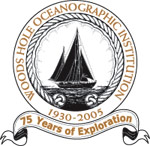This is an archived site. This site is no longer being maintained or reviewed for broken links.
Down to the Sea for Science – Science Feature
Probing the Seafloor: A Short History of WHOI Marine Geology and Geophysics
 |
|
The chain-bag dredge, shown bringing its cargo aboard Atlantis, has been an important tool for marine biologists and geologists. Maurice Ewing is at left. (WHOI Archives Photo) |
 |
|
Brackett Hersey tests electronic gear in the upper lab aboard Atlantis. He joined the WHOI staff in 1947 to run an underwater acoustics program and later became the first chairman of the Geology and Geophysics Department. Navy funding for his group played a major role in sustaining the Institution in the uncertain postwar period. After moving to the Office of Naval Research in 1966, Hersey maintained close ties at WHOI. (Photo by Don Fay) |
In 1930, the depths of the main ocean basins were known only approximately from widely spaced soundings made with lead-weighted lines and, after World I, with an early echo sounder. Geologist Henry Stetson, with a joint appointment at WHOI and Harvard’s Museum of Comparative Zoology, began to dredge rocks and core sediments from nearby continental margins during Atlantis Cruise 34 in 1934. The following year, Maurice Ewing of Lehigh University used Atlantis as a platform for adapting continental geophysical techniques to seafloor studies. Stetson’s knowledge of sediment characteristics and Ewing’s knowledge of the behavior of sound in seawater and the seafloor were both put to lifesaving use during World War II for submarine detection and defense.
After the war, Stetson continued his extensive collection of seafloor samples, taking Atlantis into the Pacific for the first time in 1955 on what was, unfortunately, his last cruise (he died at sea off Chile). Collection and analysis of seafloor rock and sediment has continued to be an important WHOI objective since then, and the Seafloor Samples Laboratory today houses more than fourteen thousand marine geological samples collected by coring, dredging, and other means. WHOI scientific and technical staff members have been key players in the progress of coring techniques in recent decades, and they are currently developing a new large-diameter coring device for retrieving sediment cores as long as 132 feet (40 meters).
Though Ewing moved from WHOI to Columbia University in 1946, he continued to use Institution ships for several years. During a seismic refraction experiment conducted from Atlantis and Caryn, he, Brackett Hersey (who had studied with Ewing for his Ph.D. degree), and other colleagues gathered firm evidence showing oceanic crust to be fundamentally different (thinner) from continental crust. Hersey was in charge of WHOI geophysics research through the mid-1960s, building a multidisciplinary group that grew to about fifty people who pioneered many new techniques and instruments, including the continuous seismic profiler for visualizing and quantifying layered sediment beneath the seafloor.
Bigger, more capable ships and improved instruments brought further progress in marine geology and geophysics, with WHOI scientists collecting data and contributing ideas to the diffuse, international dawning of the earth science revolution known as plate tectonics in the late 1960s. Today scientists in the Geology and Geophysics Department employ descendants of the early techniques and tools, as well as remotely operated and autonomous vehicles and long-term seafloor recording devices not dreamed of in the 1930s, as they advance a wide range of marine earth sciences research. They engage in a broad spectrum of studies—sedimentology, paleoceanography, seismology, geomagnetism, electromagnetics, tectonics, petrology, geochemistry, high-pressure physical properties, geomicrobiology—all of which promise a strong role for the Woods Hole Oceanographic Institution in the future of seafloor research.
This feature is based on an unpublished 2004 manuscript by WHOI scientist emeritus Richard P. Von Herzen, entitled “A Brief History of Marine Geology and Geophysics at WHOI.”

